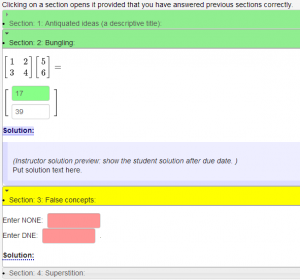Scaffolding1
This problem has been replaced with a newer version of this problem
Deprecated: Sequentially Revealed (Scaffolded) Problems
This PG code shows how to create multi-part questions that hide from students parts that have not yet been answered correct. This example is deprecated: see FortLewis/Authoring/Templates/Misc/Scaffolding2_PGML.pg instead (requires macro file scaffold.pl from after December, 2014).
- File location in OPL: FortLewis/Authoring/Templates/Misc/Scaffolding1.pg
| PG problem file | Explanation |
|---|---|
|
Problem tagging: |
|
DOCUMENT();
loadMacros(
"PGstandard.pl",
"MathObjects.pl",
"compoundProblem5.pl",
#"scaffolding.pl", # alternate future name
"PGcourse.pl",
);
TEXT(beginproblem());
$showPartialCorrectAnswers = 1;
$scaffold = Scaffold();
INITIALIZE_SCAFFOLD('$scaffold');
$isInstructor = 0; # = 0 when students use it
TEXT(MODES(
HTML=>'Clicking on a section opens it
provided that you have answered previous sections correctly.',
TeX=>''));
|
Initialization:
Use the $isInstructor = ($envir{effectivePermissionLevel} >=
$envir{ALWAYS_SHOW_SOLUTION_PERMISSION_LEVEL});
to ensure that only users that always have permission to show correct answers can open all of the sections of the scaffolding without needing to enter correct answers. |
Context("Numeric");
$answer1a = Compute(11);
$answer1b = Compute(12);
Context()->texStrings;
DISPLAY_SECTION({
section=>1,
name=>"1: Antiquated ideas (a descriptive title)",
canshow =>1,
iscorrect=>$scaffold->requireCorrect(1,2),
} , <<'END_SECTION');
Continue the pattern: 7, 8, 9, 10,
\{SECTION_ANS($answer1a->cmp), $answer1a->ans_rule(3) \},
\{SECTION_ANS($answer1b->cmp), $answer1b->ans_rule(3)\}.
END_SECTION
SECTION_SOLUTION({section=>1},<<'END_SOLUTION');
$PAR
Put some text here for the solution to section 1.
END_SOLUTION
Context()->normalStrings;
|
Section 1:
Use The text that gets displayed to students starts at "Continue..."
Use It is also possible to provide a solution for each section. |
Context('Matrix');
$M = Matrix([[1,2],[3,4]]);
$v = Matrix([[5],[6]]);
$answer2 = $M * $v;
Context()->texStrings;
DISPLAY_SECTION( {
section=>2,
name=>"2: Bungling",
canshow =>$scaffold->requireCorrect(1,2). " or $isInstructor",
iscorrect=>$scaffold->requireCorrect(3),
}, <<'END_SECTION');
\( $M $v = \) \{SECTION_ANS($answer2->cmp()), $answer2->ans_array()\}
END_SECTION
SECTION_SOLUTION({section=>2},<<'END_SOLUTION');
Put solution text here.
END_SOLUTION
Context()->normalStrings;
|
Section 2:
For kicks, we change to the matrix context.
Use |
$answer3a = Compute("NONE");
$answer3b = Compute("DNE");
Context()->texStrings;
DISPLAY_SECTION({
section=>3,
name=>"3: False concepts",
canshow =>$scaffold->requireCorrect(3). " or $isInstructor",
iscorrect=>$scaffold->requireCorrect(4,5),
}, <<'END_SECTION');
Enter ${BTT}NONE${ETT}: \{SECTION_ANS($answer3a->cmp), $answer3a->ans_rule(10)\}
$BR
Enter ${BTT}DNE${ETT}: \{SECTION_ANS($answer3b->cmp), $answer3b->ans_rule(10) \}.
END_SECTION
SECTION_SOLUTION({section=>3},<<'END_SOLUTION');
Solution text goes here.
END_SOLUTION
Context()->normalStrings;
|
Section 3:
Same syntax as before.
Since the third section is revealed only after the section section is correct, we can use |
foreach my $i (1..5) {
$answer4[$i] = Compute($i);
}
Context()->texStrings;
DISPLAY_SECTION({
section=>4,
name=>"4: Superstition",
canshow =>$scaffold->requireCorrect(5). " or $isInstructor",
iscorrect=>$scaffold->requireCorrect(6..10),
}, <<'END_SECTION');
Enter 1, 2, 3, 4, 5:
\{$answer4[1]->ans_rule(3)\},
\{$answer4[2]->ans_rule(3)\},
\{$answer4[3]->ans_rule(3)\},
\{$answer4[4]->ans_rule(3)\},
\{$answer4[5]->ans_rule(3)\}.
END_SECTION
foreach my $i (1..5) {
SECTION_ANS($answer4[$i]->cmp)
}
SECTION_SOLUTION({section=>4},<<'END_SOLUTION');
It's a little known fact that
antiquated ideas, bungling, false concepts, and superstition
are the labels on the file drawers inside of Donald Duck's brain
in the movie Donald Duck in Mathmagic Land.
END_SOLUTION
Context()->normalStrings;
|
Section 4:
We use for loops to deal with the five answers and answer checkers in this section.
Note that in the code we have pulled the The solution gives an answer to the question, "Where did the section titles come from?" |
PROCESS_ANSWERS();
$last_correct_section = PROCESS_SECTIONS();
#determine which section to leave open
$opensection = $last_correct_section + 1;
$scaffold->openSections($opensection);
COMMENT('MathObject version. Uses compoundProblem5.pl
to hide parts that the student has not yet answered correct.');
ENDDOCUMENT();
|
Answer evaluation:
Note that the answer rules and answer evaluators are matched up in the order in which they are entered, and that the question will not work otherwise.
Use |
